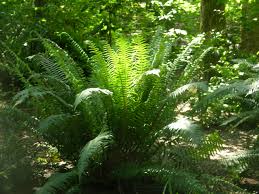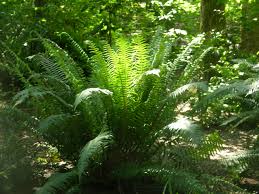Sword Fern
(Polystichum munitum)

Figure 1. Fully mature sword fern in the forest (Hansen, 2012)
Common Names
Sword Fern, Shield Fern, Christmas Fern, Sword Holly Fern
(Garden Works, n.d.; Hansen, 2012)
First Nation Names
Upriver Hulkemel’em Name: sthxhe:lum
Island and Downriver Hulkemel’em Name: sthxhelum
(SFU, n.d.)
Family
Dryopteridaceae – Wood Fern Family (Klinkenberg, 2017)
Identification
Sword ferns are an evergreen fern, with fronds that grow straight or arch slightly (Garden Works, n.d.; Hansen, 2012). Sword ferns are usually about two to three feet tall, and five to six feet wide, however they can grow up to four feet tall and eight feet wide (Hansen, 2012). A mature sword fern can have up to 100 fronds (Figure 1). In the spring, fiddleheads, or young fronds, grow and begin to slowly unroll (Hansen, 2012). Similar to other species of ferns, sword ferns reproduce using spores (SFU, n.d.). Spores in sword ferns are created in sori, which are noticeable orange/brown structures on the bottom sides of fronds (SFU, n.d.).
Cautions
None
Current Distribution and Local Habitat
Sword ferns are present in coastal temperate forests; they are present on the west coast of North America, from south-eastern Alaska to Baja California (Klinkenberg, 2017; Hansen, 2012). They are also present far from the west coast, in the Yukon, as well as in Idaho and Montana (Hansen, 2012). Sword ferns are most abundant in forest understories, and on water-receiving sites such as riverbeds, that are enhanced by the flow of organic materials (Klinkenberg, 2017). These ferns grow between sea level and mid-elevation, with abundance decreasing as elevation increases (Hansen, 2012; Klinkenberg, 2017). Sword ferns thrive with moist, nitrogen-rich soils, and almost full shade conditions (Hansen, 2012; Klinkenberg, 2017). However, sword ferns are able to still do decently well in dry, moderate nutrient level soils, with only part shade (Hansen, 2012).
Ethnobotanical Uses
Indigenous people have traditionally used nearly every part of Sword Ferns (Hansen, 2012) Some traditional uses of sword fern by indigenous peoples on the West Coast that we learned in class are using sword ferns as temporary matting or bedding and to wipe slime from fish (Class Slides). Sword ferns could also be used as food; the rhizomes can be dug in the spring, and roasted or steamed over a fire and served with salmon (TUSP, n.d.; Hansen, 2012). The rhizomes could also be eaten to cure diarrhea (Hansen, 2012). Furthermore, sword ferns have other medicinal usages; young fronds can be chewed to ease a sore throat and Lummi women chewed leaves fronds to ease the pain of childbirth (TUSP, n.d.; Hansen, 2012). The Quinalts peoples boiled sword fern roots and used the water that had been boiled to treat dandruff (Hansen, 2012). Lastly, sword fern fronds have non-stick abilities, thus the fronds have traditionally been used to spread under drying berries, to store food and keep foods separated, and for lining pit cooks to keep food off of rocks (TUSP, n.d.; Hansen, 2012; Class Lecture). View presentation on how to make headdresses and wreaths with sword fern here.
Ecological Significance
Sword ferns are understory plants in coniferous or mixed forests (Hansen, 2012). They are usually found in the same areas as other plant species such as “Vine Maple (Acer circinatum), Salal (Gaultheria shallon), Twinflower (Linnaea borealis), Cascade Oregon Grape (Mahonia nervosa), False Lily-of-the-Valley (Maianthemum dilatatum), Rusty Menziesia (Menziesia ferruginea), Western Springbeauty (Montiasibirica), Wood Sorrel (Oxalis oregona), Thimbleberry (Rubus parviflorus), Salmonberry (Rubus spectabilis), Threeleaf Foamflower (Tiarella trifoliata), Red Huckleberry (Vaccinium parvifolium), Evergreen Huckleberry (Vaccinium ovatum), Evergreen Violet (Viola sempervirens), and Pioneer Violet (Viola glabella)” (Hansen, 2012). Sword ferns have ecological relationships with these plants. Sword ferns are also a host for some butterfly species, as well as are a cover for some smaller wildlife (Hansen, 2012). Furthermore, elk, deer, black bears and beavers forage on the fern’s fronds (Hansen, 2012).
References
Garden Works (n.d.) Sword Fern; Polystichum munitum. Retrieved November 25, 2017 from http://plants.gardenworks.ca/11190002/Plant/Print/7347
Hansen, W.W. (2012). Hansen’s Northwest Native Plant Database; Polystichum munitum (Sword Fern, Christmas Fern, Sword Holly Fern). Retrieved November 25, 2017 from http://www.nwplants.com/business/catal og/pol_mun.html
Klinkenberg, B. (Ed) 2017. E-Flora BC: Electronic Atlas of the Plants of British Columbia[eflora.bc.ca]. Lab for Advanced Spatial Analysis, Department of Geography, University of British Columbia, Vancouver. Retrieved November 25, 2017 from http://linnet.geog.ubc.ca/Atlas/Atlas.aspx?sciname= Polystichum%20munitum&redblue=Both&lifeform=5
SFU (n.d.). Retrieved November 25, 2017 from http://www.sfu.ca/halk-ethnobiology/html/plants/sword fern.htm
Traditional Uses for Some of the Plants and Trees In My Backyard Powerpoint (TUSP) (n.d.) Retrieved November 25, 2017 from https://www.sfu.ca/love motherearth/08classroom/presentations/traditional_uses_for_plants.ppt
Project Status:
Year:
Associated Projects:
Image:

